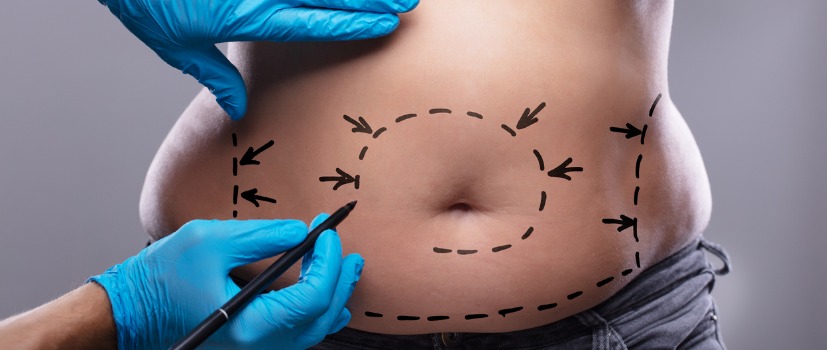Everyone has an ideal version of their body. It’s one of the reasons why we exercise, eat right, and take care of ourselves. However sometimes despite our best efforts, there can be one or two things holding you back.
Maybe you’re trying to get rid of love handles or a double chin, or maybe you want smoother and more toned arms. For these and other areas that have not responded to diet and exercise, liposuction can be a highly effective solution.
Dr. Bill Johnson and the team at Innovations Medical are leaders in advanced, minimally invasive liposuction techniques that remove fat from problem areas with less downtime. This easy-to-understand guide will provide knowledge on how liposuction works and answer key questions many patients have about this type of procedure.
What to Know Before Getting Liposuction
Liposuction, also called lipoplasty or body contouring, is a surgical procedure where fat tissue is removed from the body through a suction device. In liposuction procedures, the doctor uses a medical grade suction device that attaches to a thin tube with a blunt tip called a cannula.
The goal of liposuction is to remove fat cells by creating thousands of small holes in fat deposits while leaving the overall “spiderweb” structure of collagen intact. This will cause the fat to shrink and create an overall slimmer appearance in this area.
Liposuction is not a substitute for weight loss, and it is generally not safe to remove very large volumes of fat. Additionally, liposuction removes fat and can lighten skin. Sometimes other procedures are typically required to address issues such as severe loose skin, cellulite, or stretch marks.
Where Is Liposuction Performed?
Surgeons perform liposuction in a wide range of locations, including clinics, surgery centers, and hospitals. Tumescent procedures using local anesthesia can be performed on an outpatient basis, while general anesthesia-based liposuction requires a hospital or surgi-center setting.
On the body, this procedure is best used in areas where small deposits of fat can remain after losing weight. This includes:
- The abdomen
- Love handles
- Lower back
- Chin and neck
- Buttocks
- Thighs
Because liposuction can be performed almost anywhere on the body there is fat, patients can discuss problem areas with their surgeon. For example, many male and female patients undergo liposuction to have fat removed from the chest area.
Am I a Candidate for Liposuction?
Candidates for liposuction should be in good overall health, without any major medical conditions or immune system problems that would impair healing. Patients should be at or near overall weight loss goals and have good muscle tone and skin elasticity. Additionally, good candidates for liposuction should not smoke or use tobacco.
Talk to your doctor or cosmetic surgeon about whether liposuction is a good fit for you and your lifestyle. Patients may be advised to stop taking certain medications or supplements prior to surgery, particularly those that may cause blood thinning.
Types of Liposuction
There are many different types of liposuction that have been developed due to advances in technology and surgical techniques. These include:
- Traditional tumescent liposuction: This common approach uses a sterile saline solution combined with tumescent, or local, anesthesia, and a drug that helps blood vessels constrict, which is then injected into the area. This allows for an outpatient, “Drive-Through Liposuction.” The cannula is then inserted through tiny incisions and suctioned out through a small vacuum device.
- Laser-assisted liposuction: This type of procedure uses a laser to help break up fat cells. The SmartLipo procedure at Innovations Medical combines a laser with tumescent liposuction to suction out fat and even help smooth out skin.
- Vibration-assisted liposuction (VAL): This is an advanced form of power-assisted liposuction (PAL), using compressed air to move the cannula rapidly back and forth. VAL can be particularly effective in removing stubborn fat or larger volumes, while helping to avoid grooving and rippling which can occur in some PAL devices.
Your surgeon can help you select the technique or techniques that are right for you based on your treatment goals, targeted body areas, and previous procedures you have undergone.
Liposuction Recovery
After your liposuction surgery, you will be given detailed instructions based on your specific procedure. Patients should expect minor swelling and bruising and pain while they recover. You should receive prescription medications to help manage pain and reduce the risk of infection.
You should use compression garments to help with the swelling and be told to take it easy for a few days after the procedure. Depending on how strenuous your job is, patients may be able to return to work after a few days and up to a week. Normal activities and strenuous exercise can be resumed in a few weeks.
Results should start to become noticeable as swelling subsides over the first few weeks, and the area should take on a full leaner appearance after a few months. These results should be long lasting as long as patients maintain a healthy weight.
Risks and Complications for Liposuction
As with any surgical procedure, there are certain risks and complications that can occur in a small number of liposuction procedures. These include risk of infection, contour irregularities, fluid accumulation, and numbness in the area. In a very small number of cases, a small piece of fat can break away and get trapped in a blood vessel causing a medical emergency known as an embolism. These complications are very rare in office based settings with experienced physicians.
Liposuction should always be performed by an experienced and reputable surgeon to minimize the risk of complications.
Paying for Liposuction and Insurance Coverage
Liposuction using tumescent anesthesia generally costs around $2,000 to 4,000 for each body area. General anesthesia can add an additional $2,500 to 6,000 for the facility and anesthesiology fees. At Innovations Medical, we price our body areas as pairs, including both arms, inner thighs, upper stomach, lower stomach, or love handles. All of our procedures are done under tumescent (a form of local) anesthesia, so no anesthesiology fees are necessary.
As an elective cosmetic procedure, liposuction is usually not covered by insurance. Check with your specific carrier or health plan to find out how they cover cosmetic liposuction procedures.
Innovations Medical is dedicated to making it as easy and convenient as possible for anyone to undergo life-changing procedures such as liposuction. We offer options including flexible scheduling to break up procedures, and financing that can spread costs into affordable monthly payments. We want to deliver personalized care that can fit nearly anyone’s budget.
Contact Innovations Medical for Information
If you’re looking for a slimmer appearance, Innovations Medical is here for you. Our skilled professionals help you decide which treatment is best for you – keeping you informed and confident in the next steps. We’ve been helping our patients look and feel their best since 2005, and even our most advanced procedures are often minimally invasive.
To find out if liposuction is right for you, and to learn how Innovations Medical can improve your life, call us at (214) 643-8665 or schedule a consultation.




